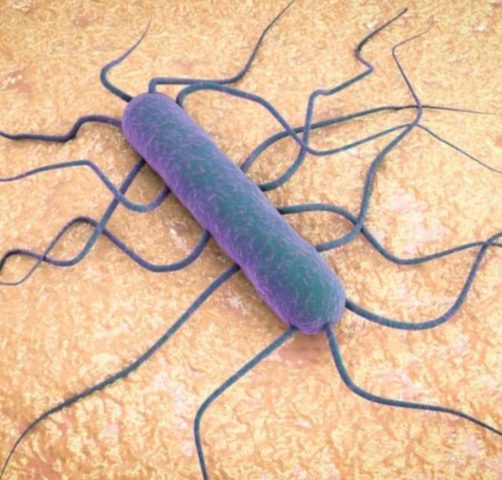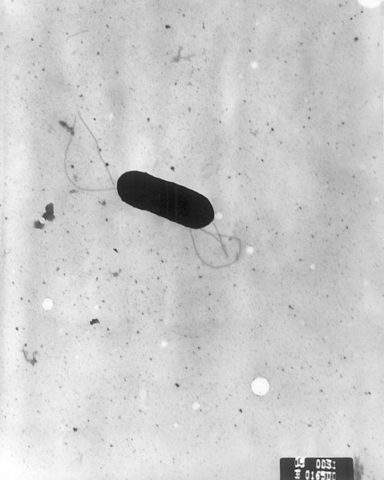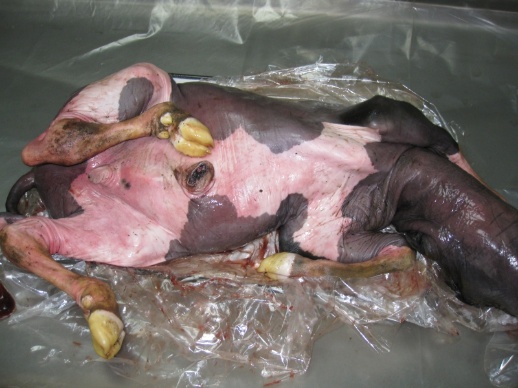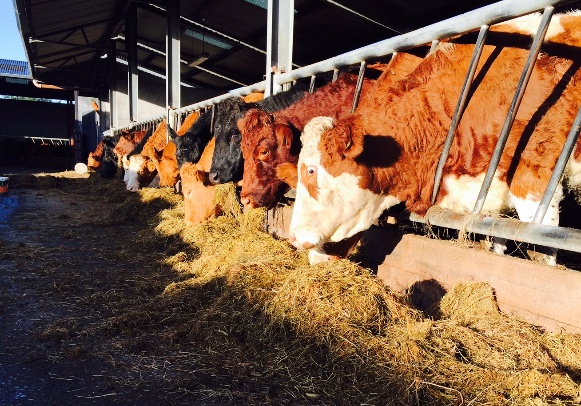Content
One of the bacterial diseases common to many animals, birds and humans is listeriosis. Pathogens are everywhere. There is even an opinion that some of them constantly live in the digestive tract of humans and other mammals. But the development of the disease occurs when the number of bacteria exceeds the critical mass. Listeriosis in cattle is especially dangerous for humans because bacteria are transmitted through unboiled milk. And the fashion for "everything natural", including "fresh milk directly from under the cow", contributes to the spread of the disease.

The causative agent of listeriosis in South Africa
What is listeriosis
An infectious disease that affects not only animals, but also humans. Because of this, the disease is among the most dangerous, although it is relatively easy to cope with it.
Listeriosis is caused by the gram-positive bacterium Listeria monocytogenes. Under the microscope, it looks very similar to E. coli, but there is a difference: a pair of flagella at both ends of the stick. Plus, Listeria is able to move and live in both oxygen and anoxic environments.
Very stable in the natural environment. At low above zero temperatures, it can survive for several years in feed, water and land. In the natural environment, Listeria was found even beyond the Arctic Circle. In this case, listeriosis is considered a focal and stationary disease.
In this regard, soft cheeses stored in the refrigerator are especially dangerous. In general, Listeria reproduce almost anywhere:
- silo;
- soil;
- grain;
- water;
- milk;
- meat;
- corpses of animals.
Rodents are considered the natural reservoir of listeriosis: synanthropic and wild. The bacteria are able to survive in oats and bran for 105 days, in meat and bone meal and hay for 134 days. They remain viable for a very long time in chilled salted meat.
Quite resistant to disinfectants and high temperatures. When heated to 100 ° C, it takes 5 to 10 minutes for the death of Listeria and 20 minutes when heated to 90 ° C. The use of a solution of bleach with a concentration of 100 mg of chlorine per 1 liter of listeria is kept for an hour.
Pets with listeriosis suffer from:
- Cattle;
- MRS;
- pigs;
- all types of domestic and decorative birds;
- cats;
- dogs.
Bacteria also parasitize in humans. Listeria has even been found in seafood and fish.
Listeria are highly variable and are able to adapt to almost any conditions, creating new forms.

The causative agent of listeriosis in the "original" form
Sources and routes of infection
The source of cattle disease with listeriosis is sick and recovered animals. Often, listeriosis is asymptomatic, since the manifestation of clinical signs directly depends on the number of bacteria that have entered the body and the immunity of a particular animal. But the absence of symptoms does not interfere with the release of pathogens into the external environment with feces and milk for such a latent carrier.
The routes of infection with listeriosis are different:
- oral;
- airborne;
- contact;
- sexual.
The main route is oral. The calf can become infected through the milk of the uterus or by eating the feces of a sick animal. Also, bacteria can be transported by ectoparasites: ticks and lice.
Adult cattle are most often infected through water or poor quality silage. The surface layers of the latter at a pH above 5.5 are ideal for the reproduction of listeriosis pathogens.

Rats are one of the main carriers of Listeria
Symptoms of listeriosis in cattle
Due to the different routes of entry and further spread in the body, the signs of listeriosis in cattle can be very diverse. In addition to the "gate" for bacteria to enter the animal's body, there are also ways to spread it inside. If listeria can enter the body of cattle through the mucous membrane of the esophagus, damaged skin or during mating, then it further spreads:
- with blood flow;
- through the lymphatic system;
- with a current of cerebrospinal fluid.
The form of listeriosis in cattle will depend on where the bacteria gets to. The severity of the course of the disease is determined by the number and strains of bacteria that have entered the body:
- spicy;
- subacute;
- chronic.
Depending on the type of course, the incubation period of listeriosis is 7-30 days.
This explains the long-term listeria and difficulties with the treatment of the disease.
Forms of the disease
Cattle can have 5 clinical forms of listeriosis:
- nervous;
- septic;
- genital;
- atypical;
- asymptomatic.
The main form is usually nervous, since Listeria are able to penetrate together with the flow of cerebrospinal fluid into the brain.
Symptoms of the nervous form
The nervous form can often carry signs of encephalitis, meningitis, or meningoencephalitis. The first clinical signs: depression, refusal to feed, lacrimation. Then, after 3-7 days, signs of damage to the central nervous system appear:
- conjunctivitis;
- loss of balance;
- "Stilted" gait;
- uncoordinated movements, sometimes whirling;
- convulsions;
- curvature of the neck;
- blindness;
- paresis of the muscles of the head: lips, lower jaw, ears;
- oglum-like state;
- stomatitis;
- bouts of violence are possible.
During illness, the body temperature is normal or elevated. The nervous phase lasts up to 4 days. Up to 100% of the livestock that showed signs of a nervous form dies.
The video shows a nervous form of listeriosis in cattle with impaired coordination of movements and twilight consciousness:
Septic form
The common name for sepsis is blood poisoning. Signs of septic listeriosis in cattle are similar:
- high body temperature;
- diarrhea;
- oppression;
- refusal of feed;
- labored breathing;
- sometimes symptoms of catarrhal enteritis.
Convulsions and coma are often observed. The septic form of listeriosis is mainly recorded in young cattle. This is due to the fact that calves usually receive a significant "portion" of Listeria with milk and manure from adult sick cows. Through the intestinal mucosa, listeria penetrate into the blood vessels. They are carried by the bloodstream throughout the calf's body. The same happens when other pathogenic microorganisms enter the bloodstream. Hence the similarity of signs with sepsis.
Genital form
Most often occurs after mating. In this case, these are the "gates" through which the causative agents of listeriosis entered the body.
Cattle have signs of genital listeriosis:
- abortion in the second half of pregnancy;
- retention of the placenta;
- endometritis;
- mastitis.
The latter does not always appear, but if it appears, then Listeria is excreted in milk for a long time.
Atypical form
Rare. Its symptoms are gastroenteritis, fever, pneumonia.It can occur when the pathogens of listeriosis enter the body in several ways at once or simply in advanced cases.
Asymptomatic form
With a small number of listeriosis pathogens or strong immunity, cattle may not show signs of the disease, being a carrier. These animals release Listeria into the environment, but appear healthy themselves. They can diagnose listeriosis only after laboratory tests.
Diagnosis of listeriosis in cattle
The primary diagnosis is made on the basis of the epizootic situation in the area. Since the symptoms of listeriosis in cattle are very similar to other bacterial diseases, differentiation is made from:
- rabies;
- brucellosis;
- Aujeszky's disease;
- encephalomyelitis;
- vibriosis;
- malignant catarrhal fever;
- chloramide poisoning;
- food poisoning;
- hypovitaminosis A.
To establish an intravital diagnosis, blood, milk and effusions from the genitals of aborted cattle queens are sent to the laboratory.

Stomatitis can be a sign of listeriosis in cattle
But this does not always give the desired effect, since, due to the high degree of variability, Listeria can look like E. coli and cocci. Because of this, grown Listeria cultures are often regarded as common microflora. Mistakes can be avoided if the culture is subcultured several times on fresh nutrient medium and a colony of bacteria is grown at room temperature. In this case, the listeria will acquire their characteristic form.
But such research is not available to the farmer or individual. Therefore, you have to rely entirely on the integrity of the laboratory staff.
Pathological changes in listeriosis in cattle
For postmortem examination for listeriosis in cattle, the following is sent to the laboratory:
- the brain, right in the head;
- liver;
- spleen;
- pancreas;
- lymph nodes;
- aborted fetus.
When opening the fetus, hemorrhages are found on the mucous membranes of the respiratory tract, in the pleura, under the epi- and endocardium. The spleen is enlarged. On its surface, foci of miliary (tissue decomposed to a curdled consistency) necrosis are noticeable. The liver with granular dystrophy, and the lymph nodes with serous inflammation.

Abortion in the second half of pregnancy is common in cattle with listeriosis
Treatment of listeriosis in cattle
The bacterium is able to penetrate into the host's cells, which is why the treatment of listeriosis is effective only in the initial stages. It is carried out with antibiotics of the penicillin and tetracycline groups: ampicillin, chlortetracycline, oxytetracycline, biomycin, terramycin, streptomycin.
Antibiotics are administered intramuscularly even before clinical signs appear. That is, those animals that still have an incubation period. Treatment after the onset of symptoms is considered inappropriate.
In parallel with antibiotic therapy, symptomatic treatment is carried out using drugs that stimulate the gastrointestinal tract, heart drugs, disinfectants and others.
If the therapy is no longer useful, the carcasses are sent for recycling. Slaughtered cattle, the carcasses of which do not yet have pathological changes, undergo deep industrial processing. They make boiled sausage. Depleted carcasses with degenerative changes in muscles are raw materials for meat and bone meal.
Forecast and prevention
Since with a nervous form, the prognosis is almost 100% hopeless, then prevention is also aimed at preventing the further spread of listeriosis. In the septic form, the central nervous system has not yet been affected, the prognosis is cautious. But in any case, treatment will be successful only at the very initial stage of listeriosis.
Because of this, all measures are usually aimed at prevention. It is carried out taking into account epizootic data:
- natural focus of listeriosis;
- periodicity;
- stationarity.
The quality control of feed is carried out. To prevent contamination of forage with excrement of rodents-carriers of listeriosis, systematic deratization is carried out. The transmission of listeriosis by blood-sucking parasites is prevented by no less regular disinsection of the cowshed and pastures.
Strict control is carried out over the quality of silage and compound feed, as the most probable ways of infection of cattle. Samples of feed are periodically taken for research in the laboratory.
To prevent the introduction of listeriosis into the farm, the herd of cattle is completed from prosperous farms. When buying new individuals, a monthly quarantine is required.
During the quarantine, a comprehensive examination of new animals is carried out and samples of bacteriological and serological studies for listeriosis are taken for analysis. Especially if suspicious clinical signs were found among the new animals:
- high temperature;
- abortion;
- symptoms of central nervous system damage.
The cattle farm maintains a strict record of deaths, abortions and stillbirths. When mastitis appears, take milk for bacteriological examination. If an infection with listeriosis is detected, the economy is rehabilitated.

New cows are allowed into the herd only after quarantine
Wellness
If cases of disease are detected among cattle, control over the situation is transferred to the jurisdiction of the State Veterinary Inspectorate and the State Sanitary and Epidemiological Supervision. The farm veterinarian must immediately report the detected listeriosis to the manager and the above-mentioned organizations. In this situation, “household” means not only farms, but also private yards.
After the farm is declared unfavorable, it is prohibited:
- movement of animals outside the quarantine zone, with the exception of export for slaughter;
- export of meat from cattle forcedly slaughtered from listeriosis, except for its transfer to a meat processing plant for processing;
- removal of feed from the territory;
- selling unprocessed milk.
Milk must either be boiled for 15 minutes or processed into ghee.
To identify asymptomatic cattle and listeri carriers, a general examination and blood sampling for serological studies are carried out. Individuals with a positive reaction are isolated and treated with antibiotics or killed. Cattle queens are artificially inseminated with the sperm of healthy bulls.
All feed samples are taken for research. Deratization of areas where feed is stored is carried out. If the causative agents of listeriosis are found in the silage, the latter is disinfected using a biothermal method. Hay and grain feed, in which rodents are found, are disinfected by heating to 100 ° C for half an hour.
The farm is recognized as safe 2 months after the last case of manifestation of clinical signs of listeriosis and the final disinsection, deratization and disinfection of the premises, adjacent territories and feed. But the export of animals outside the farm is permissible only 1 year after the elimination of the outbreak of listeriosis.
In a farm that has survived an outbreak of listeriosis, once a year, before stalling cattle in winter, a serological examination is carried out. Cattle that show a positive reaction are isolated and either treated or slaughtered. When removing cattle from such a farm, the veterinary certificate must indicate the results of the check for listeriosis.
Conclusion
Listeriosis in cattle is a quarantine disease that can also be contracted by service personnel. Since it is almost not amenable to treatment, all sanitary rules must be observed on the farm. It will not be possible to completely eradicate Listeria from the environment, but the risk of contamination of livestock with bacteria can be significantly reduced.









The article helped a lot, but there is no answer - how to treat the room after animals with listeriosis